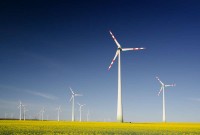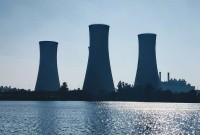- Home
- Business Processes
- Industry Knowledge
- Aerospace Industry
- Automotive Industry
- Banking Domain
- BFSI Industry
- Consumer/ FMCG Industry
- Chemicals Industry
- Engineering & Construction
- Energy Industry
- Education Domain
- Finance Domain
- Hospitality Domain
- Healthcare Industry
- Insurance Domain
- Retail Industry
- Travel and Tourism Domain
- Telecom Industry
- Leadership Skills
- eLearning
- Home
- Industry Knowledge
- Energy Industry
- Energy Industry – Trends
Energy Industry – Trends
The energy industry is going through the biggest transformation in history. The impact of energy production and consumption on the environment is varied and mankind has started understanding the importance of improving energy efficiency and ensuring energy security for all. The current trend is to explore sustainable energy options that can provide power to future generations.
The increasing use of energy since the Industrial Revolution has also brought with it a number of serious problems, some of which, such as global warming, present potentially grave risks to the world.
Energy Conservation
Energy is essential to life and the key to human progress. Its conservation is essential in modern industrial societies. Coal and other fossil fuels are likely to be depleted soon because once consumed, they are no longer available to us in the same form. Today, 85% of the primary energy comes from fossil fuels. Their reserves are finite and will not exist for future generations as the consumption increases with an increasing population. Considerable wastage of energy is taking place in our world. We have to learn to use the energy resources judiciously to avoid energy death for our future generations. For this, we need to understand what energy resources are available to us and for how long. How can we make them last longer? Energy conservation becomes important in this context.
Economic Impact of the Energy Industry
Production and consumption of energy resources are very important to the global economy. All economic activity requires energy resources, whether to manufacture goods, provide transportation, run computers, and other machines. Widespread demand for energy may encourage competing for energy utilities and the formation of retail energy markets. The energy sector accounts for 4.6% of outstanding leveraged loans, compared with 3.1% a decade ago. Energy bonds make up 15.7% of the $1.3 trillion junk bond market, up from 4.3% over the same period.
Impact of Population Growth
It is thus abundantly clear that access to affordable energy is fundamental to human activities, development, and economic growth. Without access to electricity and clean fuels, people’s opportunities are significantly constrained. Population growth and competition for resources have continuously been an impetus for the control and use of energy. In harnessing energy, inventions evolved from previous innovations, ebbing and flowing with changes in population pressures and the availability of resources—necessity shaping history.
The world is suffering increasingly from environmental problems, many of which, if not all, may be traced to the uncontrolled use of energy and related resources by an ever-increasing global population. On the one hand, the industrially developed part of the world consumes fossil fuel to generate the energy needs of its inhabitants and industries, and to provide transportation both on the ground and in the air. At the other end of the social spectrum, the developing world suffers from an acute shortage of energy needed for development.
Environmental Impact
The whole world is dependent on energy in one form or another. We depend on energy right from lighting to water supply, to food preparation and up to the launching of satellites. Advancements in agricultural mechanization have led to an improvement in rural livelihood and food security. In developing countries, grid-based electricity and diesel are used to carry out agricultural operations. There are issues associated with these traditional sources of energy for example, diesel is a fossil fuel that is fast depleting and pollutes the environment. Further, the operational cost of diesel power is considerably high when compared to hydro-electricity which is less expensive and non-polluting.
The generation, transportation, and use of energy carriers, unfortunately, come with undesired effects. The environmental impacts are multifaceted and serious, although mostly less evident. Emissions of suspended fine particles and precursors of acid deposition contribute to local and regional air pollution and ecosystem degradation. Human health is threatened by high levels of air pollution resulting from particular types of energy use at the household, community, and regional levels. Emissions of anthropogenic greenhouse gases (GHG), mostly from the production and use of energy, are altering the atmosphere in ways that are affecting the climate.
Sustainable Development of Energy Industry
Developing capacity among all stakeholders in all countries, especially in the public sector, to address issues related to energy for sustainable development. Adoption of policies and mechanisms to increase access to energy services through modern fuels and electricity for the 2 billion. Advancing innovation, with a balanced emphasis on all steps of the innovation chain: research and development, demonstrations, cost buy-down, and wide dissemination.
Regulatory Framework
The regulation will be required to set appropriate market framework conditions (including continued market reform, consistent regulatory measures, and targeted policies) to encourage competitiveness in energy markets, to reduce the total cost of energy services to end-users, and to protect important public benefits. Moving to cost-based prices and phasing out all forms of permanent subsidies for conventional energy. Removing obstacles and providing incentives, as needed, to encourage greater energy efficiency and the development and/or diffusion of new technologies for energy for sustainable development to wider markets.
Alternative Transportation Fuels
Alternative transportation fuels are those fuels not derived from petroleum. They include not only those derived from renewable sources but also natural gas and its derived fuels. Flex-fuel vehicles are vehicles that can operate with multiple fuels (or fuel blends). Such technology was created in 1980 and there are around 2 million flex-fuel vehicles in the United States today. The main fuels used include gasoline and several alternative fuels, such as pure ethanol (already used in Brazil in automotive vehicles) and blends of ethanol and gasoline.
Clean Coal Technology
Clean coal technologies can have a major impact on the world’s economy by allowing the continued use of coal in an environmentally acceptable manner, thus reducing dependence on more expensive petroleum and natural gas, while avoiding economic problems caused by natural gas price fluctuations.
Although natural gas is expected to fuel many new power plants and industrial facilities to meet growing demand over the next two decades, it is critical to maintaining fuel flexibility, thus enabling the use of low-cost indigenous fuels, such as coal.
Unfortunately, in addition to carbon and hydrogen, most coals contain sulfur, nitrogen, minerals, and chlorine, in various concentrations. Coals also contain trace elements, such as mercury, lead, arsenic, cadmium, selenium, thorium, and uranium, in very small concentrations, generally only a few parts per million. When coal is burned, the trace elements may be released to the environment in various, sometimes harmful, forms. In the past, coal combustion has contributed to acid rain, smog, forest die-off, eutrophication of lakes, and other environmental problems. Because such impacts are no longer acceptable, new methods to reduce harmful emissions from plants utilizing coal are needed. Technology to accomplish this is generally referred to as clean coal technology (CCT).
Global Warming
More than 100 years ago, Svante Arrhenius suggested that CO2 emissions from fossil fuel burning could raise the infrared opacity of the atmosphere enough to warm Earth’s surface. During the 20th century, the human population quadrupled and humankind’s energy consumption rate increased 16-fold, mainly from increased fossil fuel combustion. In recent years, observational confirmations of global warming from the fossil fuel greenhouse have accumulated, and we have come to better understand the interactions of fossil fuel burning, the carbon cycle, and climate change. Stabilizing CO2 concentration in the atmosphere at any specified level will require progressively more stringent emission reductions. However, even a total cessation of emissions would not restore preindustrial levels for more than millennia. The technology challenge of the century may be to reduce fossil fuel CO2 emissions enough to prevent unacceptable climate change while population, energy use, and the world economy continue to grow.
The energy industry is undergoing a rapid transformation.
Related Links
You May Also Like
-
The history of human culture can be viewed as the progressive development of new energy sources. Developments in the energy industry have resulted in unparalleled transformations of society. It is because of the availability of energy sources that humans have been able to increase comfort, longevity, and affluence, as well as their population apart from unprecedented growth. Each energy fuel alternative has also impacted different combinations of economic, political, technological, social, and environmental attributes.
-
Most of the energy we use today is being obtained from coal and petroleum. There are some sources of energy, which can be used repeatedly without exhausting them, such as, energy from the sun, energy from a water-fall, wind energy, tidal energy. This industry comprises of alternative energy and sustainable energy companies, including those involved in hydroelectric power, wind power, and solar power generation, and the manufacture, distribution, and sale of alternative fuels.
-
Nuclear power is the use of sustained nuclear fission to generate heat and electricity. Nuclear power plants provide about 6% of the world's energy and 13–14% of the world's electricity, with the U.S., France, and Japan together accounting for about 50% of nuclear-generated electricity. In 2007, the IAEA reported there were 439 nuclear power reactors in operation in the world, operating in 31 countries.
-
Energy is essential to life and the key to human progress. Energy is the common link between the living and non-living realms of the universe, and thus provides an organizing intellectual theme for diverse disciplines. Energy growth is directly linked to well-being and prosperity across the globe. Meeting the growing demand for energy in a safe and environmentally responsible manner is a key challenge.
-
This is the traditional industry based on the collection and distribution of firewood, the use of which, for cooking and heating, is particularly common in poorer countries. People have needed energy in some form for their everyday lives for hundreds of years. Primitive man (about 1 million years B.C.) used fire to cook food and over the period of human development. The energy industry was probably born the day when our ancient ancestors first discovered that they could keep themselves warm and cook food with fire.
-
The energy industry is going through the biggest transformation in history. The impact of energy production and consumption on the environment is varied and mankind has started understanding the importance of improving energy efficiency and ensuring energy security for all. The current trend is to explore sustainable energy options that can provide power to future generations.
-
The modern electric power industry covers the generation, transmission, distribution, and sale of electric power to the general public and industry. The commercial distribution of electric power started in 1882 when electricity was produced for electric lighting. In the 1880s and 1890s, growing economic and safety concerns lead to the regulation of the industry. What was once an expensive novelty limited to the most densely populated areas, reliable and economical electric power has become an essential aspect for normal operation of all elements of developed economies!
-
These industries include petroleum industries (oil companies, petroleum refiners, fuel transport and end-user sales at gas stations) coal industries (extraction and processing), and the natural gas industries (natural gas extraction, and coal gas manufacture, as well as distribution and sales). Most of the energy we use today is being obtained from coal and petroleum. We also have nuclear power plants. But these energy sources are limited as only finite quantities of coal; petroleum and gas exist underground or in oceans.
-
The energy is comprised of companies involved in the exploration and development of oil or gas reserves, drilling, and refining and integrated power companies working on renewable and coal energy. This industry locates fuel resources, processes them, and finally involved in the production and sale of energy. Access to affordable energy is fundamental to human development, and economic growth as without electricity and power, human opportunities are significantly constrained.
Explore Our Free Training Articles or
Sign Up to Start With Our eLearning Courses

About Us
Learning
© 2023 TechnoFunc, All Rights Reserved









